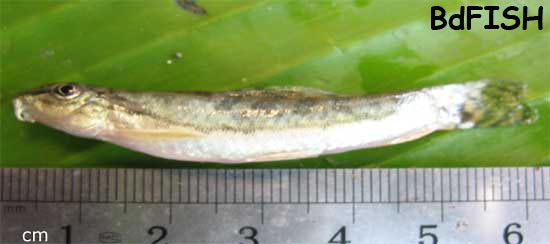
Synonyms:
Cobitis botia Hamilton, 1822
Cobitis bilturio and turio Hamilton, 1822
Nemachelus botia Gunther, 1868
Nemacheilus botia Day, 1878
Nemacheilus botia, Talwar and Jhingran, 1991
Noemacheilus botia Menon, 1974
Nemachilus botia Rahman, 1989
English name: Mottled loach, Zipper loach, Sand loach (Parween, S; 2007)
Common name: Botia loaches
Local name: Balichata, Bilturi, Natwa (Parween, S; 2007)
Taxonomy position:
Phylum- Chordata
Class-Oesteichthyes
Order- Cypriniformes
Family- Cobitidae
Genus- Acanthocobitis
Species- Acanthocobitis botia
Fin formula:
D.13 (2/11); P1. 10; P2. 8 (1/7); A. 6 (I/5). (Rahman, 2005)
D iii 9-11; A iii 5; P i 11; V i 7 (Talwar and Jhingran, 1991)
Description of the species:
Dorsal profile is slightly arched, ventral profile flat. Body elongate, cylindrical, anteriorly, compressed posteriorly. Body depth is 4.5–5.9 times in standard length. Mouth crescentric, surrounded by fleshy lips, lower lip notched at middle farming two rounded lobes. Eyes situated high, near dorsal surface, 4 rostal and 2 maxillary barbells. Dorsal fin is much nearer to snout than to caudal base. Pectorals nearly as long as head, reaching below origin of dorsal. Edge of dorsal straight 10-14 irregular dark bands descend from back and end in dark spots below lateral line, 5-6 longitudinal rows of spots in dorsal, caudal with five > shaped bands formed of spots. (Rahman, 1989; Talwar and Jhingran, 1991)
Largest specimen examined was only 62 mm long from river Barnai, longest specimen collection 6.5 cm by Rahman (1989) and 7 cm by Talwar and Jhingran (1991).
Habit and Habitat:
In hill streams and clean water creeks of Sylhet, in streams of Mymensingh, Dinajpur and Rangpur (Rahman, 1989). Clean water, swift flowing streams with bottom of rocks, pebbles and sand are good habitat. This fish feeds on zoobenthos and insect larvae (Parween, S; 2007).
Economic importance:
The species is of interest as an aquarium fish. Hilly people love to eat them (Parween, S; 2007).
Status and Conservation:
This species is not very common in Bangladesh (Parween, S; 2007) but not listed as threatened in IUCN Red book of threatened fish of Bangladesh by IUCN Bangladesh. This species considered as data deficient in this book (IUCN Bangladesh, 2000).
.
References:
Day, F. 1878. Fishes of India, being a natural history of fishes known to inhabit the seas and freshwaters of India, Burma and Ceylon. William Dawson & Sons Ltd., London, Vol. I: p 552.
Gunther, 1868, Cat Fish Brit, Mus., 7, p. 349
Hamilton, F., 1822. An account of the fishes found in the river Ganges and its branches, Edinburgh & London, Fishes Ganges, 350-358.
IUCN Bangladesh. 2000. Red Book of Threatened Fishes of Bangladesh. IUCN- The World Conservation Union. xii+116 pp.
Menon, A. G. K. 1974, A Checklist of the Fishes of the Himalayan and the Indo-gangetic Plains. Inland Fisheries Society India, Barrackpore, p 53.
Parween, S; 2007. Acanthocobitis botia (Hamilton, 1822). In: Siddiqui, K.U., Islam, M.A., Kabir, S.M.H., Ahmed, M., Ahmed, A.T.A., Rahman, A.K.A., Haque, E.U., Ahmed, Z.U., Begum, Z.N.T., Hasan, M.A., Khondker, M., and Rahman, M.M. (eds.). Encyclopedia of Flora and Fauna of Bangladesh, Vol. 23. Freshwater Fishes. Asiatic Society of Bangladesh, Dhaka. p.96.
Rahman, A.K.A. 2005. Freshwater Fishes of Bangladesh (Second edition). The Zoological Society of Bangladesh, Department of Zoology, University of Dhaka, Dhaka-1000. 394 pp.
Rahman, A.K.A. 1989. Freshwater Fishes of Bangladesh. The Zoological Society of Bangladesh, Department of Zoology, University of Dhaka, Dhaka-1000. p 145.
Shaw and Shebbeare, 1937, The Fishes of Northern Bangal. Journal of Royal Asiatic Society of Bengal Science. 3 (8), p.71.
Talwar, P. K. and Jhingran, A. G., 1991. Inland Fishes of India and Adjacent Countries. Volume 1. Oxford & IBH Publishing Co. Pvt. Ltd. New Delhi, Calcutta. p 472.
Visited 1,098 times, 1 visits today | Have any fisheries relevant question?
